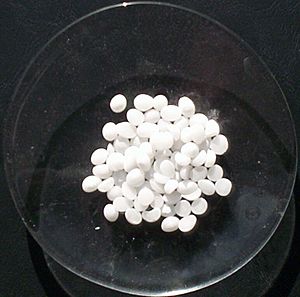Potassium hydroxide facts for kids
Potassium hydroxide is a common chemical compound. Its chemical formula is KOH. It is also known as caustic potash or lye. This chemical contains potassium and hydroxide ions.
What it is like
Potassium hydroxide is a white powder. It dissolves very easily in water, creating a strong basic solution. This solution is corrosive, meaning it can harm your skin. It reacts with acids to form different potassium salts.
Potassium hydroxide is not as common as sodium hydroxide, but about 700,000 tons are made each year. It is a hygroscopic substance, which means it loves to absorb water from the air. When it does, it turns into a solution, and it's very hard to get the water out again!
When potassium hydroxide dissolves in water, it releases heat, just like sodium hydroxide. Over time, it slowly reacts with carbon dioxide in the air to create potassium carbonate. It also melts easily. If it gets on your skin, it might feel greasy because it reacts with the fats in your skin to make a kind of soap.
How it is made
Potassium hydroxide is usually made through a process called electrolysis. This involves passing electricity through a solution of potassium chloride.
It can also be made by mixing calcium hydroxide with potassium carbonate. In this reaction, calcium carbonate forms a solid that can be filtered out, leaving behind the potassium hydroxide solution.
What it is used for
Potassium hydroxide has many uses:
- It is used to make soap.
- It is important in organic chemistry experiments.
- It helps make fertilizers and other potassium compounds.
- It can be used to make biodiesel from plants.
- It acts as an electrolyte in some batteries, like alkaline cells and nicad batteries.
- It can even be used to help identify different types of mushrooms.
Related pages
See also
 In Spanish: Hidróxido de potasio para niños
In Spanish: Hidróxido de potasio para niños



